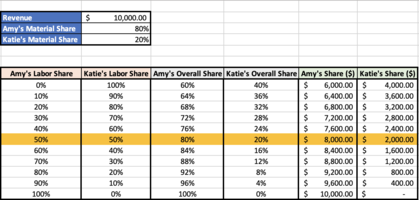MathBoggled
New member
- Joined
- Jan 20, 2023
- Messages
- 8
I need to get a percent of a percent...kind of. This isn't simple averaging, though. We have 2 percentages for 2 people:
Amy has paid for 80% of the materials. Katie has paid for 20%
Amy has done 50% of the labor. Katie has done 50%
In this scenario, for a $10,000 payment amount, the labor is a wash so Amy would get 80%: $8000 and Katie would get 20%: $2000.
However, if the labor was instead Amy does 60% of the labor and Katie does 40% of the labor, Amy should walk away with a bit more because her labor contribution increased. If doing an average, the the take-home pay decreases, so that is not the answer. How do I obtain the end % to disperse to Amy and Katie?
Amy has paid for 80% of the materials. Katie has paid for 20%
Amy has done 50% of the labor. Katie has done 50%
In this scenario, for a $10,000 payment amount, the labor is a wash so Amy would get 80%: $8000 and Katie would get 20%: $2000.
However, if the labor was instead Amy does 60% of the labor and Katie does 40% of the labor, Amy should walk away with a bit more because her labor contribution increased. If doing an average, the the take-home pay decreases, so that is not the answer. How do I obtain the end % to disperse to Amy and Katie?

